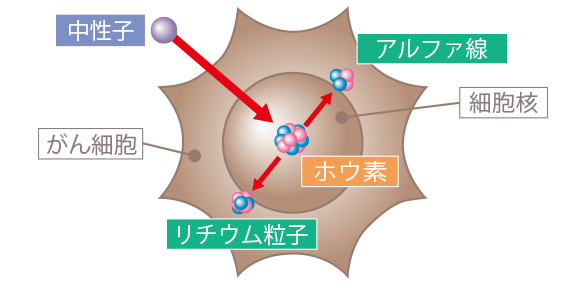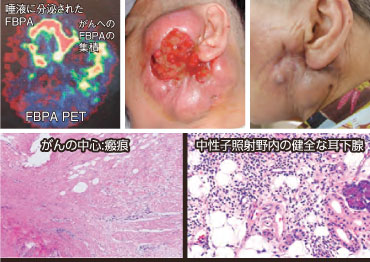Which cancers can boron neutron capture therapy treat?
- Normal Liver Cells Found to Promote Cancer Metastasis to the Liver
- Nearly 80% Complete Remission: Breakthrough in ADC Anti-Tumor Treatment
- Vaccination Against Common Diseases May Prevent Dementia!
- New Alzheimer’s Disease (AD) Diagnosis and Staging Criteria
- Breakthrough in Alzheimer’s Disease: New Nasal Spray Halts Cognitive Decline by Targeting Toxic Protein
- Can the Tap Water at the Paris Olympics be Drunk Directly?
Which cancers can boron neutron capture therapy treat?
Which cancers can boron neutron capture therapy treat? In March 2020, the Japanese Ministry of Health, Labour and Welfare approved medical equipment and boron drugs for boron neutron capture therapy.
So far, boron neutron capture therapy has been officially approved for clinical cancer treatment. As a new generation of radiotherapy, boron neutron capture therapy has received great attention. So what is the boron neutron capture therapy and what cancers can be treated?

Picture source: BNCT Research Center, South Tohoku, Japan
1. Boron neutron capture therapy
Principles of Boron Neutron Capture Therapy (BNCT)
During treatment, the patient is first injected with a boron-containing drug. This drug has a strong affinity with cancer cells and will quickly accumulate in the cancer cells, but is rarely distributed in other tissues. Then the lesion is irradiated with neutrons. When the irradiated neutrons are captured by the boron in the cancer cells, the two produce nuclear fission and release extremely lethal rays, thereby achieving the effect of blasting the cancer cells from the inside of the cancer cells. The entire treatment process usually only needs to be irradiated once.
To put it simply, the boron compound is delivered to the cancer lesion and irradiated with neutron rays to destroy cancer cells through the nuclear reaction between neutrons and boron.

Schematic diagram of the principle of boron neutron capture therapy, sourced from the BNCT Research Center of South Tohoku, Japan
Features of boron neutron capture therapy:
1 The damage to normal cells is much less than other radiotherapy
2 Cancer that recurs after radiotherapy can also be treated
3 Effective for invasive cancer, multiple cancers, and anti-radiation cancers
4 The treatment cycle is short (1 to 2 irradiations are completed, and the irradiation time is about 30 to 60 minutes for one irradiation. The proton heavy ion therapy is generally about 5-20 times)
5 The effect of treatment can be predicted through PET examination
6 No need for oxygenation effect: it can kill not only oxygen-rich cells, but also hypoxic cells and cells in quiescent phase
2. Which cancers can be treated with boron neutron capture therapy?
At present, the indications for boron neutron capture therapy in Japan are: unresectable locally advanced or locally recurrent head and neck cancer (excluding brain tumors).
In addition, brain tumors, head and neck cancer, malignant melanoma, lung cancer, pleural mesothelioma, liver cancer, breast cancer and other diseases have also undergone clinical trials of BNCT treatment. So far, there have been more than 400 cases of brain tumors and more than 30 kinds of malignant melanomas. Tumors and 130 cases of head and neck cancer were treated with BNCT.

Boron neutron capture therapy for head and neck cancer, sourced from the Japanese Society for Neutron Capture Therapy
Which patients can undergo boron neutron capture therapy?
●must be an adult
●Local recurrence of squamous cell carcinoma after platinum-containing radiotherapy and chemotherapy (including patients who refuse to use platinum drugs)
●Unresectable locally advanced squamous cell carcinoma (limited to patients who refuse to chemotherapeutic)
●Unresectable locally advanced non-squamous cell carcinoma (both untreated and recurrent patients, including patients who refuse surgery)
Which patients cannot receive boron neutron therapy?
1) The location of the lesion is deeper
Tumors that spread to the nasopharynx, oropharyngeal mucosal walls, and metastases to the posterior pharyngeal lymph nodes are all in the deep, so there are more cases that are not applicable (the thinner facial bones are OK).
2) All lesions are located on one side, but exceed the effective range (depth 6cm, 6cm parallel to the body surface skin).
If the size of the lesion exceeds the effective range, it is judged as not applicable because it cannot be cured.
3) There is distant transfer
4) The tumor infiltrates the carotid artery or surrounds it for more than half a week.
It is believed that the rapid shrinkage of the tumor will cause the carotid artery to rupture and increase the risk of death due to treatment
5) Tumor infiltrates the skull base:
Due to the formation of the fistula leading to intracranial infection, the risk of death due to treatment is extremely high.
If there is a slight possibility, a contrast MRI is needed for evaluation.
6) The primary cancer is not head and neck cancer
7) Stromal tumors, such as sarcoma and hematological tumors
8) Active inflammation
9) Have dental caries and have not completed the treatment
10) Patients who need regular oxygen, such as chronic lung disease
11) Patients with renal insufficiency and heart failure
12) Patients with epilepsy
13) Patients with claustrophobia and uncontrolled mental illness
14) Patients who are pregnant or wish to become pregnant during treatment
15) Patients with pacemakers or ICD implants
*In the case of other indwelling metals in the body, it is necessary to determine whether it is suitable for treatment based on the confirmation of its composition. However, the case where the filling in the tooth is metal is not limited.
That’s it for the introduction of boron neutron capture therapy and its indications. If you want to know more about the Japanese boron neutron capture treatment plan, please leave a comment.
(source:internet, reference only)
Disclaimer of medicaltrend.org



